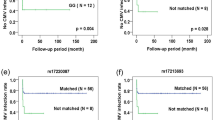Abstract
Variable number tandem repeats (VNTRs) were among the first genetic markers used to quantitate bone marrow transplant engraftment. The limitations of PCR-based VNTR markers in distinguishing some donor/recipient pairs has shown the need for additional genetic markers to analyze engraftment. Short tandem repeats (STRs) provide an excellent tool for this purpose because of their high degree of polymorphism and relatively short length. We compared STR analysis results with previous VNTR results for 16 post-transplantation samples from four allogeneic bone marrow transplant patients. Previously analyzed patient samples were chosen to cover the full range of engraftment. DNA samples from each patient were analyzed in a blinded fashion. Good quantitative correlation was found between STR and VNTR results in samples from all four patients. STR markers were informative in one patient for whom PCR-based VNTR markers were not available. Correlation of VNTR and STR methods helps to validate the use of STRs for the quantitative analysis of bone marrow transplant engraftment. This study demonstrates that STR-based human identity testing kits are well suited for engraftment analysis.
Bone Marrow Transplantation (2002) 29, 243–248. doi:10.1038/sj.bmt.1703360
This is a preview of subscription content, access via your institution
Access options
Subscribe to this journal
Receive 12 print issues and online access
$259.00 per year
only $21.58 per issue
Buy this article
- Purchase on Springer Link
- Instant access to full article PDF
Prices may be subject to local taxes which are calculated during checkout



Similar content being viewed by others
References
Van Deerlin VM, Leonard DG . Bone marrow engraftment analysis after allogeneic bone marrow transplantation Clin Lab Med 2000 20: 197 225
Leclair B, Fregeau CJ, Aye MT, Fourney RM . DNA typing for bone marrow engraftment follow-up after allogeneic transplant: a comparative study of current technologies Bone Marrow Transplant 1995 16: 43 55
Scharf SJ, Smith AG, Hansen JA et al. Quantitative determination of bone marrow transplant engraftment using fluorescent polymerase chain reaction primers for human identity markers Blood 1995 85: 1954 1963
Sreenan JJ, Pettay JD, Tbakhi A et al. The use of amplified variable number of tandem repeats (VNTR) in the detection of chimerism following bone marrow transplantation. A comparison with restriction fragment length polymorphism (RFLP) by Southern blotting Am J Clin Pathol 1997 107: 292 298
Luhm RA, Bellissimo DB, Uzgiris AJ et al. Quantitative evaluation of post-bone marrow transplant engraftment status using fluorescent-labeled variable number of tandem repeats Mol Diagn 2000 5: 129 138
Alford RL, Hammond HA, Coto I, Caskey CT . Rapid and efficient resolution of parentage by amplification of short tandem repeats Am J Hum Genet 1994 55: 190 195
Moretti TR, Baumstark AL, Defenbaugh DA et al. Validation of short tandem repeats (STRs) for forensic usage: performance testing of fluorescent multiplex STR systems and analysis of authentic and simulated forensic samples J Forensic Sci 2001 46: 647 660
Frankel W, Chan A, Corringham RE et al. Detection of chimerism and early engraftment after allogeneic peripheral blood stem cell or bone marrow transplantation by short tandem repeats Am J Hematol 1996 52: 281 287
Blau IW, Basara N, Serr A et al. A second unrelated bone marrow transplant: successful quantitative monitoring of mixed chimerism using a highly discriminative PCR-STR system Clin Lab Haematol 1999 21: 133 138
Thiede C, Florek M, Bornhauser M et al. Rapid quantification of mixed chimerism using multiplex amplification of short tandem repeat markers and fluorescence detection Bone Marrow Transplant 1999 23: 1055 1060
Nuckols JD, Rasheed BK, McGlennen RC et al. Evaluation of an automated technique for assessment of marrow engraftment after allogeneic bone marrow transplantation using a commercially available kit Am J Clin Pathol 2000 113: 135 140
Wallin JM, Buoncristiani MR, Lazaruk KD et al. TWGDAM validation of the AmpFlSTR blue PCR amplification kit for forensic casework analysis J Forensic Sci 1998 43: 854 870
Boerwinkle E, Xiong WJ, Fourest E, Chan L . Rapid typing of tandemly repeated hypervariable loci by the polymerase chain reaction: application to the apolipoprotein B 3′ hypervariable region Proc Natl Acad Sci USA 1989 86: 212 216
Budowle B, Chakraborty R, Giusti AM et al. Analysis of the VNTR locus D1S80 by the PCR followed by high-resolution PAGE Am J Hum Genet 1991 48: 137 144
Nakamura Y, Holm T, Gillilan S et al. Isolation and mapping of a polymorphic DNA sequence (pTHH59) on chromosome 17q [D17S4] Nucleic Acids Res 1988 16: 3598
Acknowledgements
We thank Dr Ron McGlennen for providing patient samples for this study from the Fairview-University Medical Center Molecular Diagnostics Laboratory; Dr Marie Lacy for her kind assistance in computer graphics and database utilization; Dr Elliot Landaw for help in data analysis; and the UAMS Office of Grants and Scientific Publications for their editorial assistance during the preparation of this manuscript. This article is a ‘United States Government Work’ paper as defined by the US Copyright Act.
Author information
Authors and Affiliations
Rights and permissions
About this article
Cite this article
Schichman, S., Suess, P., Vertino, A. et al. Comparison of short tandem repeat and variable number tandem repeat genetic markers for quantitative determination of allogeneic bone marrow transplant engraftment. Bone Marrow Transplant 29, 243–248 (2002). https://doi.org/10.1038/sj.bmt.1703360
Received:
Accepted:
Published:
Issue Date:
DOI: https://doi.org/10.1038/sj.bmt.1703360
Keywords
This article is cited by
-
Phase I non-randomized clinical trial of allogeneic natural killer cells infusion in acute myeloid leukemia patients
BMC Cancer (2023)
-
Can novel methods replace the gold standard chimerism method after allogeneic hematopoietic stem cell transplantation?
Annals of Hematology (2023)
-
Donor-Derived Leukemia in a Recipient of Double-Unit Cord Blood Transplantation for Acute Myeloid Leukemia: A Case Study and Literature Review
Oncology and Therapy (2022)
-
European experience and risk factor analysis of donor cell-derived leukaemias/MDS following haematopoietic cell transplantation
Leukemia (2019)
-
Importance of day 21 BM chimerism in sustained neutrophil engraftment following double-unit cord blood transplantation
Bone Marrow Transplantation (2012)



